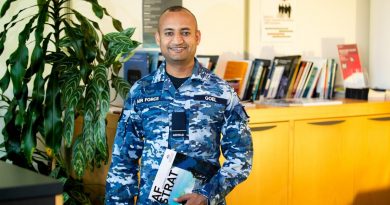Remote, part-time role perfect for mum

The war memorial in Auburn, South Australia, honours soldiers from the district that died in World War I.
CAPTION: Captain Laura McCarthy is serving part-time under Service Category 3, and is pictured with her children at home. Story by Jessica Cameron. Photo by Corporal Brenton Kwaterski.
For local resident, Captain Laura McCarthy, the legacy of the fallen runs through her veins.
Although she lives more than 100 kilometres from a major military base, Captain McCarthy is keeping the traditions of Army alive, albeit with a few changes.
Captain McCarthy works remotely three days a week as SO3 Culture and Diversity at the Army People Capability Branch as a Service Category 3 (SERCAT 3) Reserve member.
Improving gender diversity in Army is the focus of Captain McCarthy’s work, and she wants to see more women in Army, and at all levels of the organisation.
“I am passionate about this work because I see how traditional gender stereotypes are holding our society back from being the best we can be, and I want to help make a change in that area, however small,” Captain McCarthy said.
Change is something that Captain McCarthy has embraced throughout her life.
It was back in 2000, while studying at university, that a visit to an information stall run by the Adelaide University Regiment changed the course of her career.
“A friend of mine had just joined and gone to Kapooka. I had never considered a career in the Army before I met someone that had,” Captain McCarthy said.
“I was there for about a year and I wasn’t enjoying uni. I was actually enjoying my officer training and thought that I’d like to do this full-time.”
After graduating from the Royal Military College – Duntroon in December 2002 as a SERCAT 7 (full-time) member, Captain McCarthy was assigned to the Royal Australian Signals Corps and took up a variety of signals postings, later posting as a platoon commander at the Army Reserve Training Centre at Kapooka, NSW, then as brigade risk manager at Headquarters 17th Combat Services Support Brigade.
Since transferring to the reserves in 2008, Captain McCarthy has worked in Defence industry, pursued further study, had children, and even been a small business owner, but has always maintained a commitment to Army, thanks to the choices available under the Total Workforce System (TWS).
Army’s Future Ready Workforce Portfolio is working to embed the TWS across the organisation.
The TWS enables members more flexible options and agency to transfer between service categories at various stages of their lives.
For Army, it provides more people and more teams, for more missions, more often.
Captain McCarthy has since served across multiple service categories, from SERCATs 7, 5 and now 3.
“SERCAT 3 is much more manageable for my situation in terms of logistics. It gives me the opportunity to be able to contribute in the way that I’m able to,” Captain McCarthy said.
“Working three days remotely from my home means I can balance my home life, and I’m also studying, so it means I can finish my studies as well.”
Although she agrees it can be a challenge to ensure that units can provide meaningful work for SERCAT 3 members, the return is worth it.
“We know that diverse teams are more capable teams and get better outcomes because each person is able to contribute something different,” Captain McCarthy said.
Over a century on from Australia’s involvement in World War I, the nature of warfare, and indeed, society, has changed.
People such as Captain McCarthy, who display motivation and desire to be part of the change, are integral in building a workforce that is ready now, and future ready.
The Future Ready Workforce Portfolio is responsible for delivering Army’s modernisation transformation program and shaping the future workforce.
.
.

.
.





